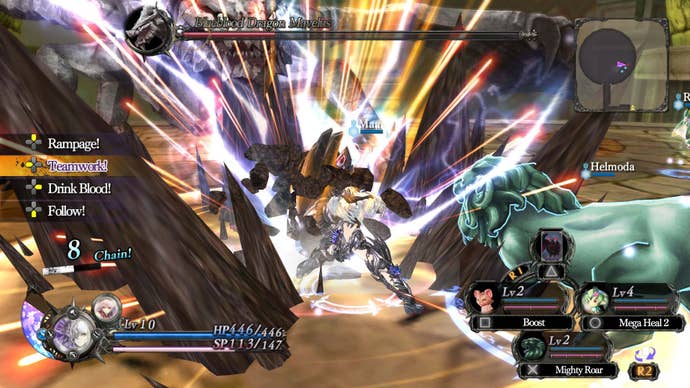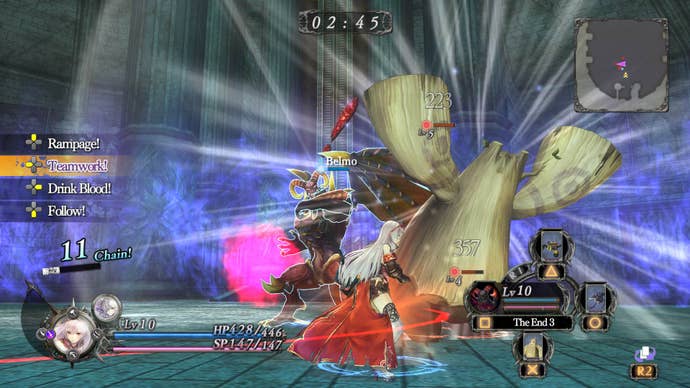Nights of Azure PlayStation 4 Review: The Last Dinosaur, In Lingerie
Gust's new action RPG resembles a relic of the PS2 era... one dressed for her wedding night.
This article first appeared on USgamer, a partner publication of VG247. Some content, such as this article, has been migrated to VG247 for posterity after USgamer's closure - but it has not been edited or further vetted by the VG247 team.
The curious contradiction of Nights of Azure, a Gust-developed hack-and-slash with light RPG elements: It feels like a game no one makes anymore, and yet it feels like every game these days.
The latter isn't too hard to explain. Azure was developed by Gust, after all, best known for developing the ever-expanding Atelier series and spin-offs like Ar Tonelico. Azure breaks away from those games' methodical RPG systems, but it retains their anime-soaked stylings. The game consists of a curious mix of detailed artistry, by-the numbers design and writing clichés, and distracting moments of visual jank.
Needless to say, Azure also contains a tremendous amount of titillation, as you might expect from a Gust-developed game centered around two female leads. It definitely isn't a game you play in mixed company; the cut scenes obsessively depict (and focus on) its heroines' ample bosoms nearly bursting from their clothes, swaying and bouncing violently with the slightest motion. And then you have the handful of "dream" sequences in which the tough-as-nails lead character walks around in wedding-night lingerie in order to power up... a scenario justified with the same flimsy narrative excuse as is given for improbably revealing female outfits in Metal Gear Solid V and the upcoming Star Ocean sequel. She needs to show as much skin as possible, because it's the source of her power... of course.
I'm not ranting against sexuality here. This game would be better for some honest sexuality rather than what it actually contains, which is more akin to giggling 11-year-olds peeking at porn sites on the classroom computer while their teacher's looking the other way. Azure's peek-a-boo costuming and "boobs don't work that way" breast physics don't ruin the game, but they do give it an unfortunate, pandering, juvenile vibe during moments in which the game legitimately seems to be working toward something more sophisticated.
While the larger plot in Azure involves an endless cycle of sacrifices to thwart the enroachment of a demonic power (think Final Fantasy X and you pretty much have the gist), the fulcrum of the story lies in the relationship between its two main characters. Arnice (a silver-haired warrior who looks suspiciously like Devil May Cry's Dante while in action, not even counting the fact that she's a half-demon devil hunter) and Lilysse (a gentle maiden destined to be the next sacrifice to fend off the Demonlord) are two childhood friends reunited by the game's events, and their relationship has a lot more subtext than mere friendship. The dialogue and staging of their interactions initially comes off as a string of awkward clichés — Lilysse is clumsy and can't cook, and that's meant to be comedy, like it was the last dozen times we saw a meek anime girl who suffered from those same foibles — but the further you work your way into the story, the more nuanced it becomes. While the game never quite calls them lovers, at the very least it becomes clear that they do love each other, even if that love dare not speak its name. So the constant campy titillation sits at odds with the more sincere story being told here, as if the developers were afraid no one would pay attention if the characters' breasts weren't flopping around comically during heartfelt conversations.

Keep trying, video games industry. Someday, you'll get it right.
Thankfully, even if Gust cheapens its story beats with soulless pandering, the rest of the game proves immune to the obligatory anime skeeziness. The bulk of Nights of Azure takes the form of a fast-paced and refreshingly straightforward hack-and-slash. Arnice may look like the Rule 63 version of Dante, but in combat she lacks his technical finesse. Azure keeps things simple and to the point, giving the heroine a handful of different weapons to wield and a few simple combos to use for them. Like the characters in her fellow Koei Tecmo-published musou games (e.g. Samurai Warriors), Arnice can chain together strong and weak attacks, perform a super move that clears out her spirit meter, and perform simple evasive rolls. Combat in Azure doesn't get too much more complicated than that, and chances are you'll likely find the weapon whose rhythm works best with your play style and stick with that.
If this were the full extent of the play mechanics, Azure would be a short game, and easily ignored. However, it takes surprising inspiration from a forgotten chapter of the Castlevania series, of all things, and places a heavy emphasis on summoning a legion of demonic assistants to fight alongside Arnice as she takes on other demons. This works a great deal as it did in Castlevania: Curse of Darkness: You can put together a "deck" of four different demons, which you can summon individually or en masse. Evoking a demon costs a healthy chunk of Arnice's spirit points, but once called forth each AI-controlled demon has its own individual health and spirit meter. They'll hang around and contribute to the fight until defeated, at which point you can't summon them again until a cooldown meter has cleared.

The demons you can actualize from fetishes are the exact same monsters you battle in standard combat, which can be a little confusing at times — the only visual cue to distinguish your demons from the bad ones is a tiny dot of color on its health meter on the heads-up display. Functionally, though, your demons have considerable advantages over the trash mobs: You can equip them with different gear to boost their stats or confer party bonuses, like permanent passive group health regeneration or abbreviated cooldown penalties upon defeat. As your demons level up, you can assign different traits and perks to them. Each demon has its own combat mode, be it healer, attacker, or support, and as you build Arnice's skills you can unlock the ability to gain multiple decks — essentially mixing-and-matching parties, which is what your demons amount to.
For such a simple game, you'll find Azure contains a surprising number of subsystems. Arnice deals with several different forms of currency — cash for buying goods, demon blood for more esoteric purposes, experience, and personal stats — and while these can interlock in interesting ways, they also lead to an awful lot of grinding. You boost Arnice's experience level with blood, which opens up the possibility of buying new combat skills or boosts with her attribute points (stamina, finesse, etc.), which can in turn open up the ability to take on more quests or passive skill-building options. The critical path through the story doesn't take all that long to complete, but in order to boost up Arnice's abilities to be able to take on the enormously powerful bosses you really need to spend a lot of time boosting her stats and those of her demons.
The bosses can be frustrating, because they're so much more taxing than the standard combat sequences. Sure, that's to be expected, but bosses are several orders of magnitude more difficult than normal encounters, and there's really no way to prep or practice for them short of grinding up more skills. Demons play an essential role in boss battles, since enemies are generally more likely to target your companions than they are Arnice, but this has its downside: If a boss and its minions manage to wipe out your host of helpers, its attention turns entirely to you for the several minutes it takes before you can call your companions again. Arnice does have one other trick up her sleeve for tough situations, though: She can transform briefly into a full-demon form with high defense and ferocious attack. Naturally, her alternate forms require powering up with experience and blood currency as well....

With its simple environments, choppy animation, and no-nonsense action, Nights of Azure feels like a game that tumbled directly out of the PlayStation 2 era and landed in 2016, getting a colorful high-definition graphical upgrade along the way. And that's a good thing, in my opinion. It took me a while to warm up to Azure, but once all the systems became available and the narrative began to move beyond stilted anime clichés, it clicked. In an era where mainstream console games that don't march in lock-step with universal trends have become fleeting and rare, Azure cheerfully looks back a decade for its inspiration and bizarrely comes out feeling distinct and inventive as a result of this regressive approach. It shouldn't work, but it does.
I suppose the irony here is that back when games like Azure were common, they never seemed like anything special. Case in point, Azure's direct inspiration, Curse of Darkness: It's one of the few Castlevania games I've barely spent any time with. But now, Azure brings back those mid-’00s mechanics, and it stands apart from its contemporaries in every way except its light patina of softcore sleaze. But if you can forgive the developers their caving to the inevitable expectations of the gal-game market — seemingly the only way console games can turn a profit in Japan these days — you'll find a fun, fast-paced, and disarmingly unpretentious action game beneath the independently mobile bosoms... as well as an unexpectedly touching story.
InterfaceAzure's control scheme manages to do quite a lot, though it's not as customizable as I'd prefer; I kept accidentally triggering Arnice's super attack when I meant to evade.
Lasting AppealA simple game, with fairly limited play mechanics, but it has enough sidequests (and requisite grinding) to last for quite a while.
SoundA big part of the game's PS2 vibe comes from its hard-rockin' soundtrack, which is great. And I'm grateful the dialogue is Japanese with subtitles; a lot of this dialogue would not work in spoken English.
VisualsBeautiful character models and settings, if you don't look too closely. Then you'll see the clumsy animations and sparse environments.
ConclusionI didn't expect to enjoy Nights of Azure as much as I do, especially given its frustrating habit of cheapening its female protagonists by presenting them as both serious characters and jiggly eye candy. Beyond the jank and titillation, though, Azure offers an action experience that speaks to a different era of gaming and plays like nothing else I've seen in years — regressive, perhaps, but in a good way. And the characters are ultimately strong enough, and developed enough, to be both likable and substantial as they navigate a minefield of boilerplate anime clichés and malfunctioning wardrobes. Not a game for everyone, but one that's better than you'd probably think.








